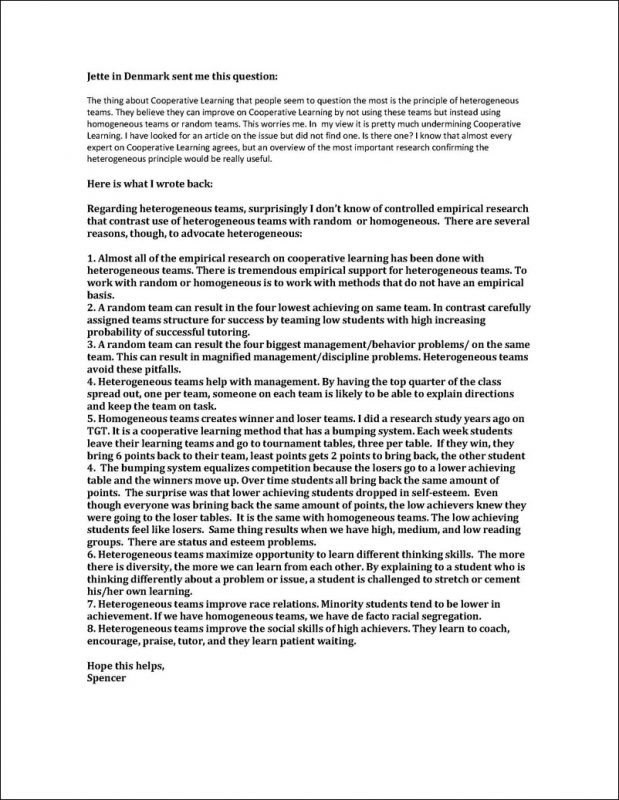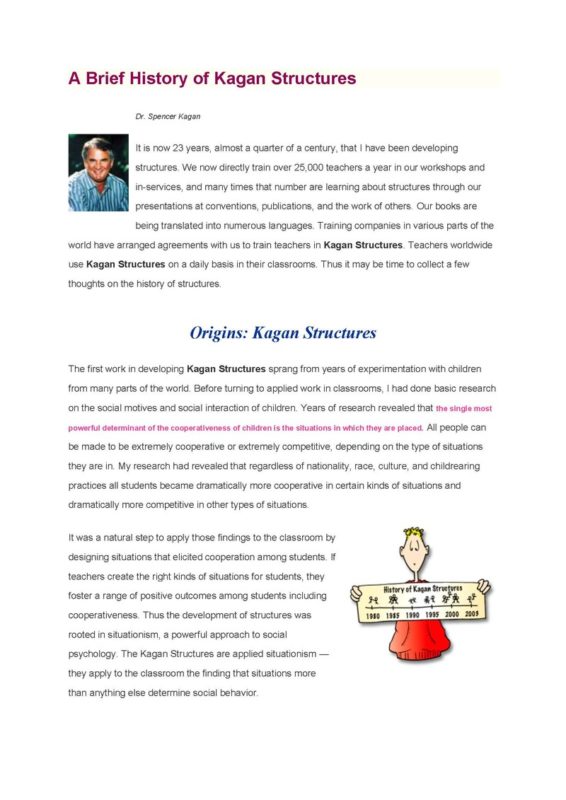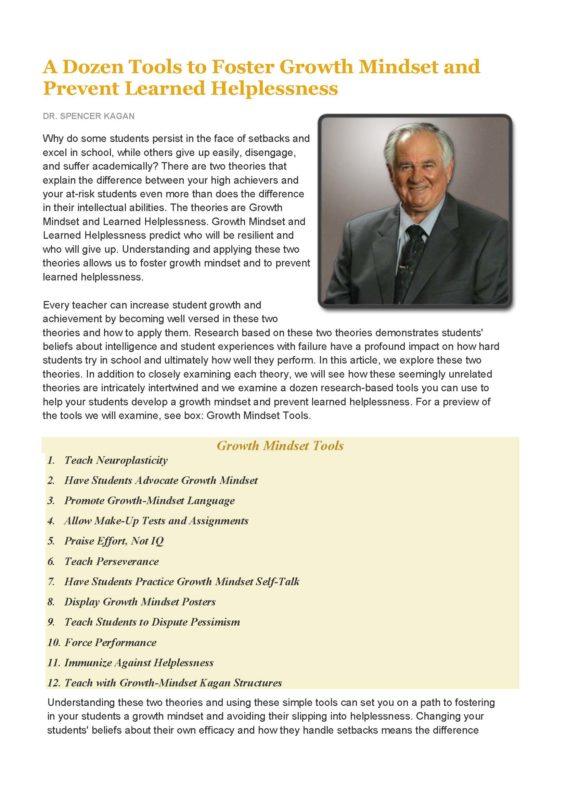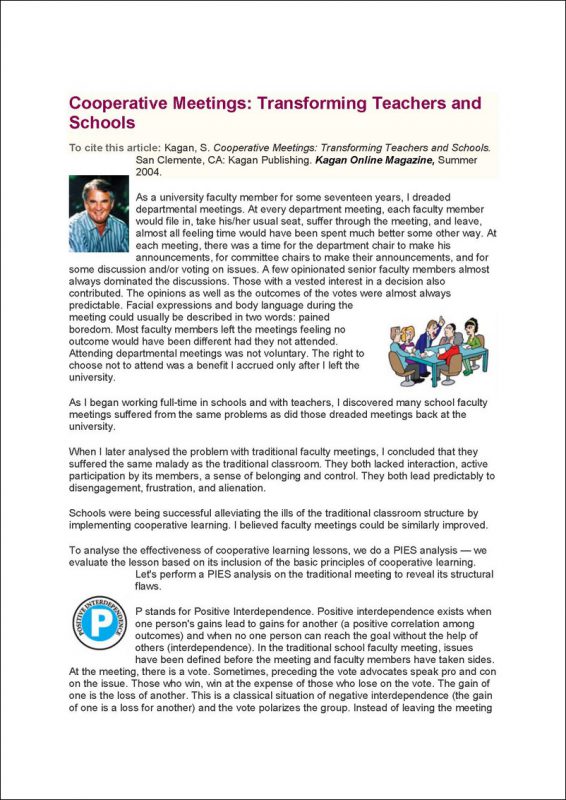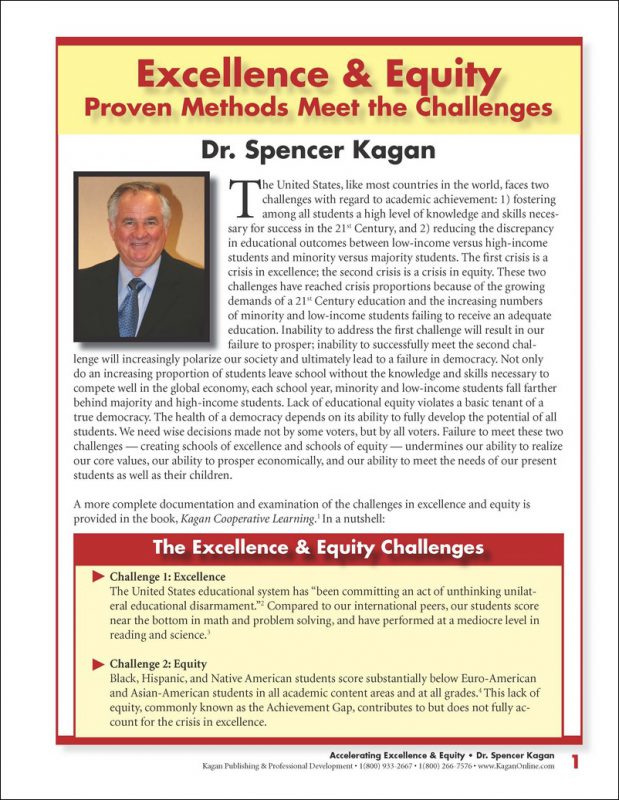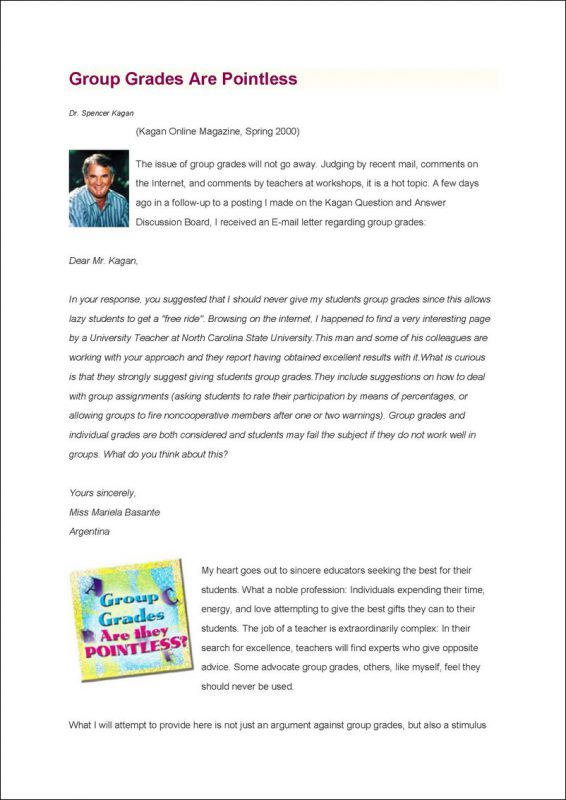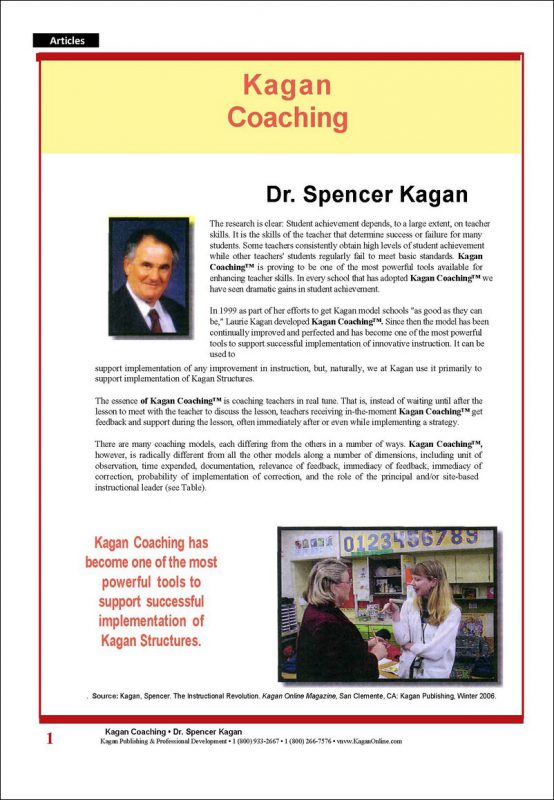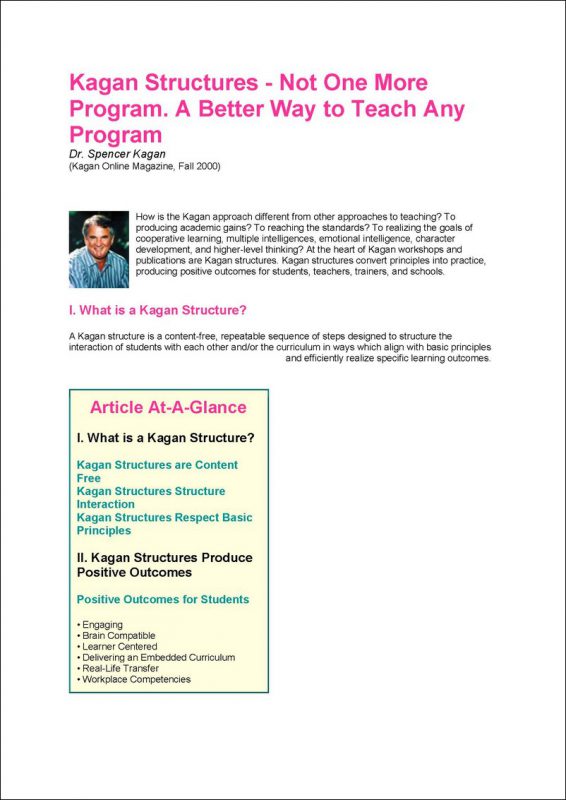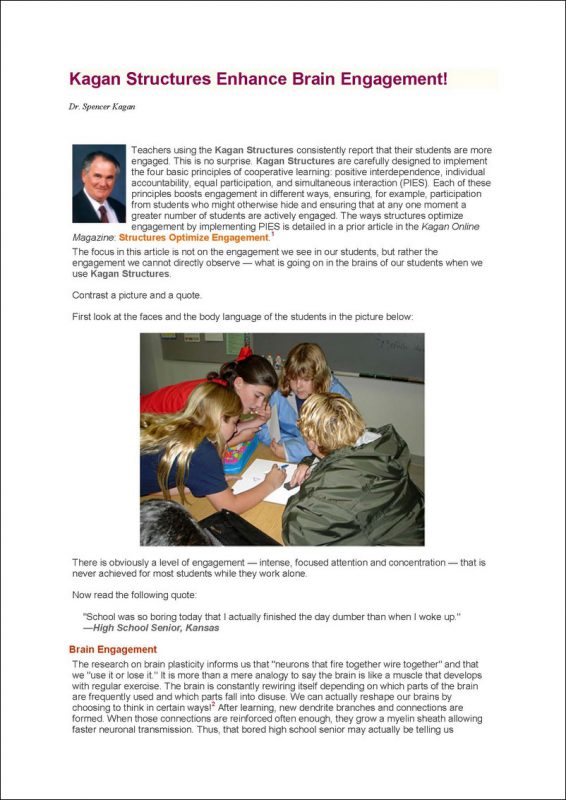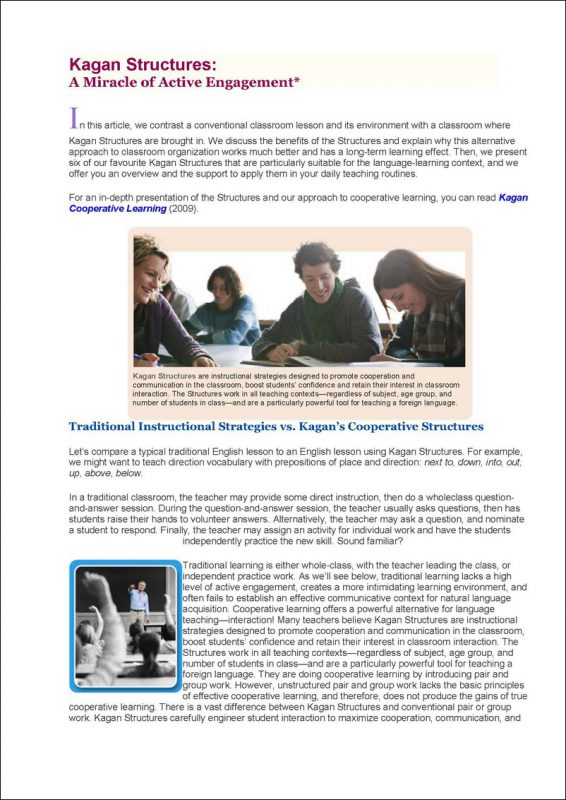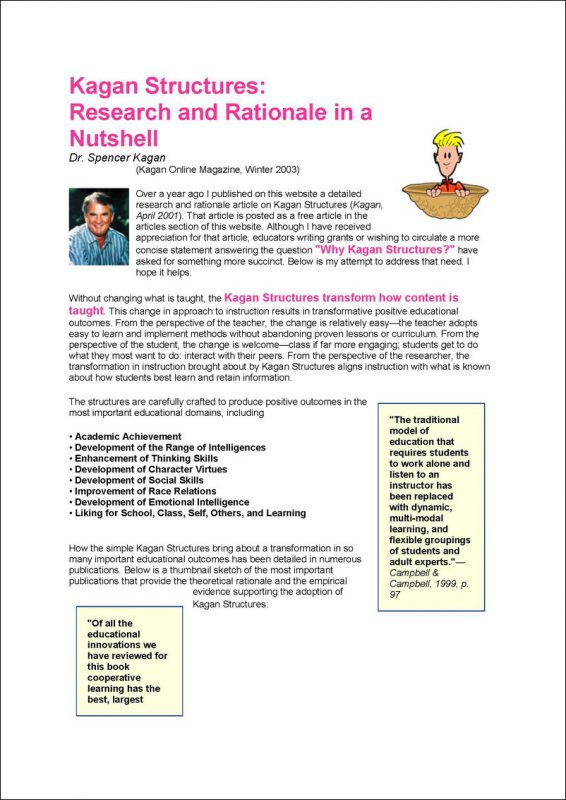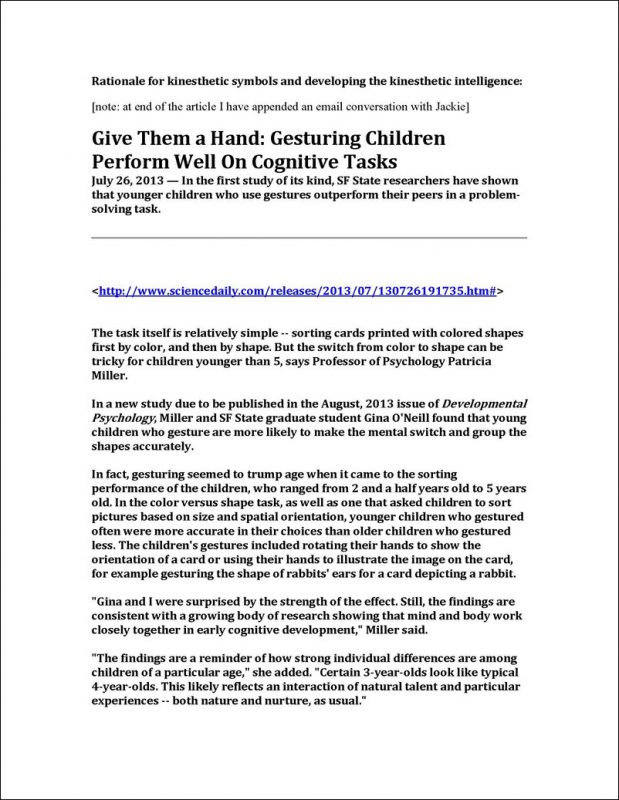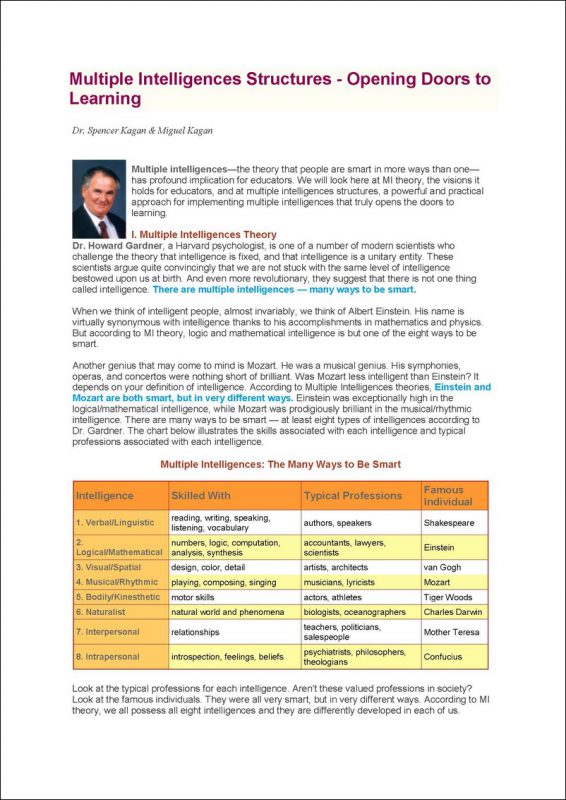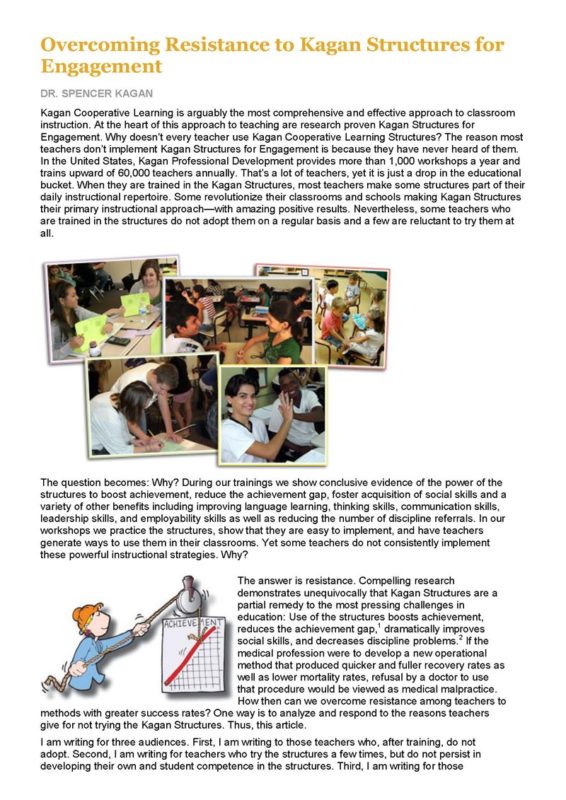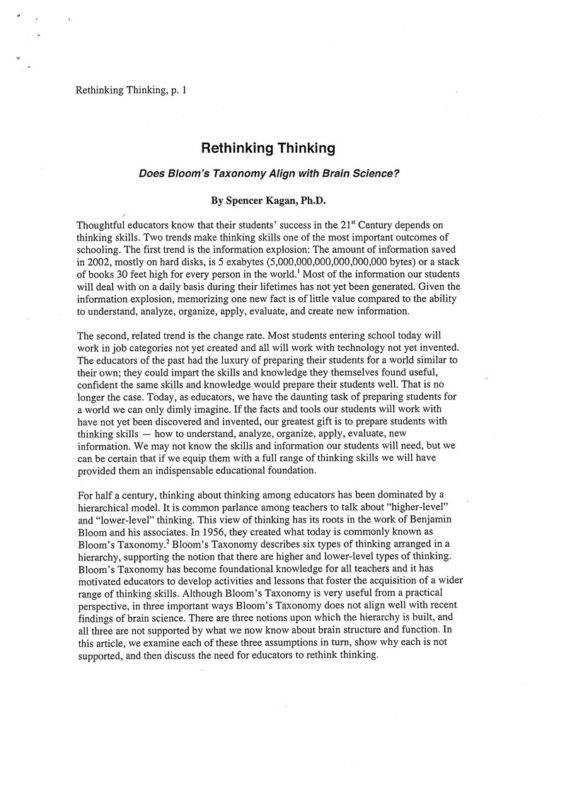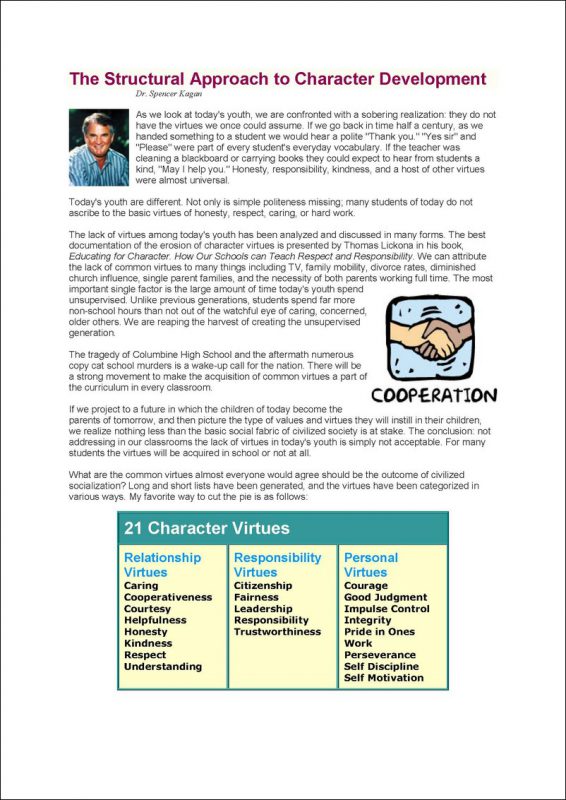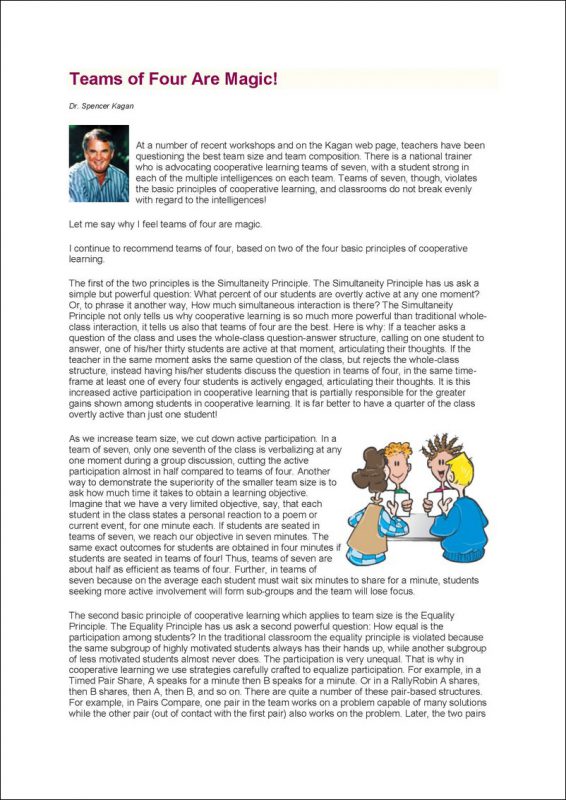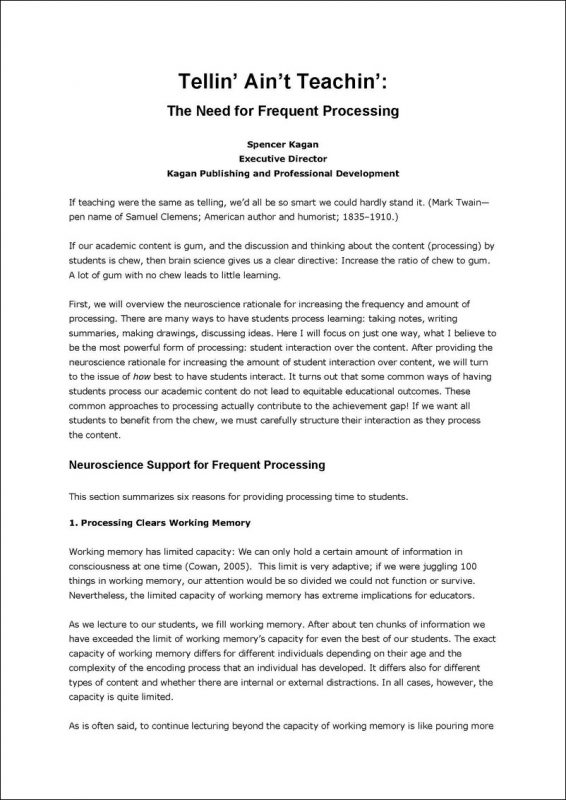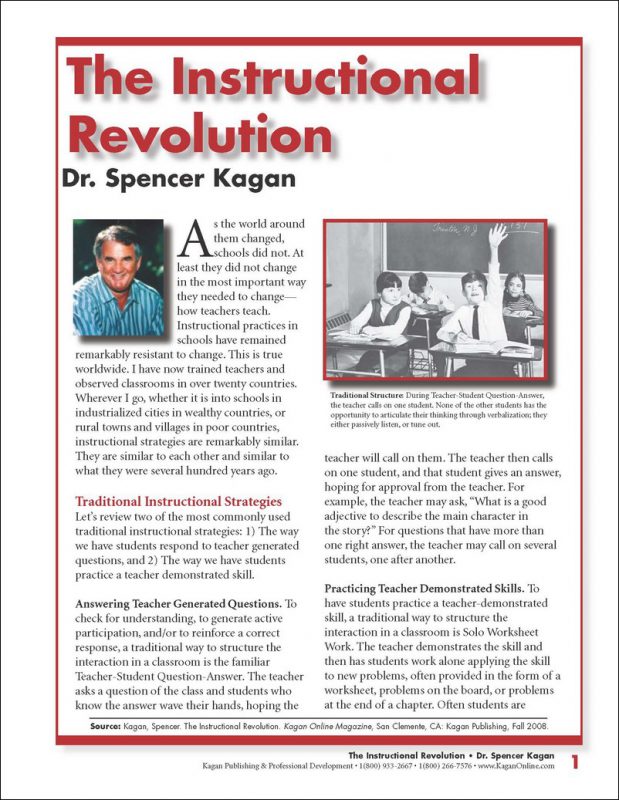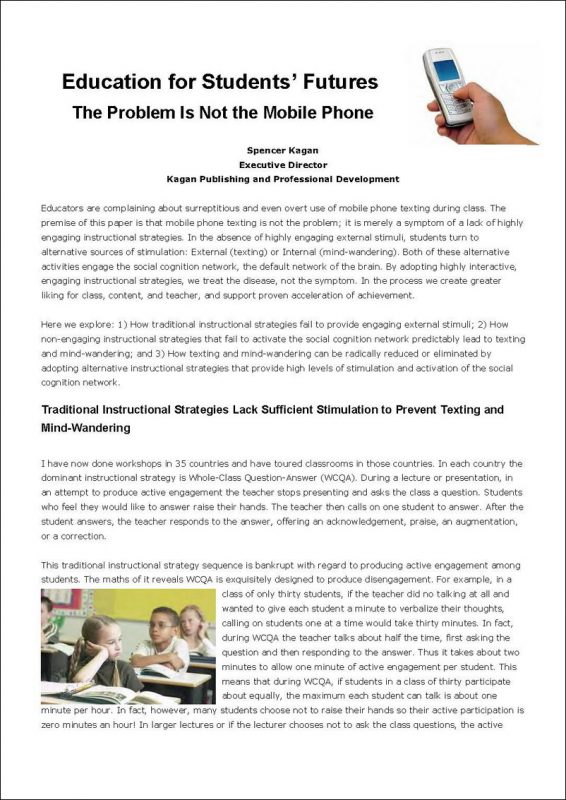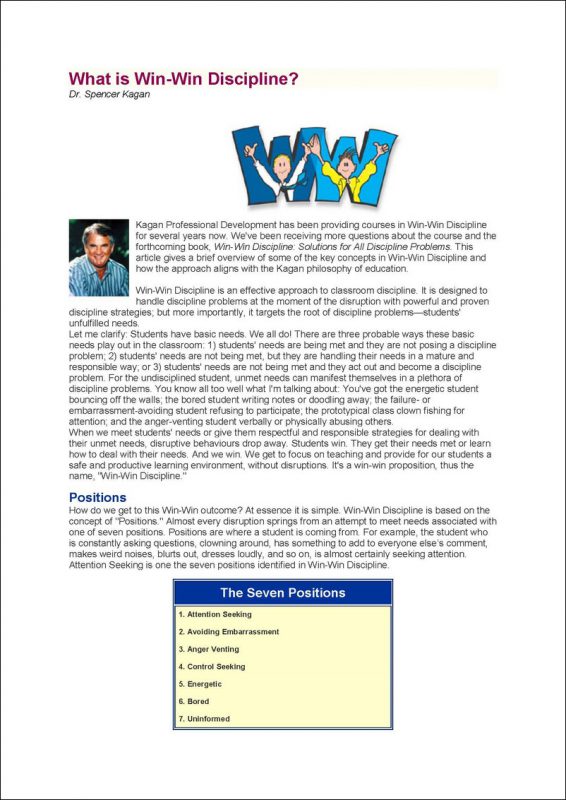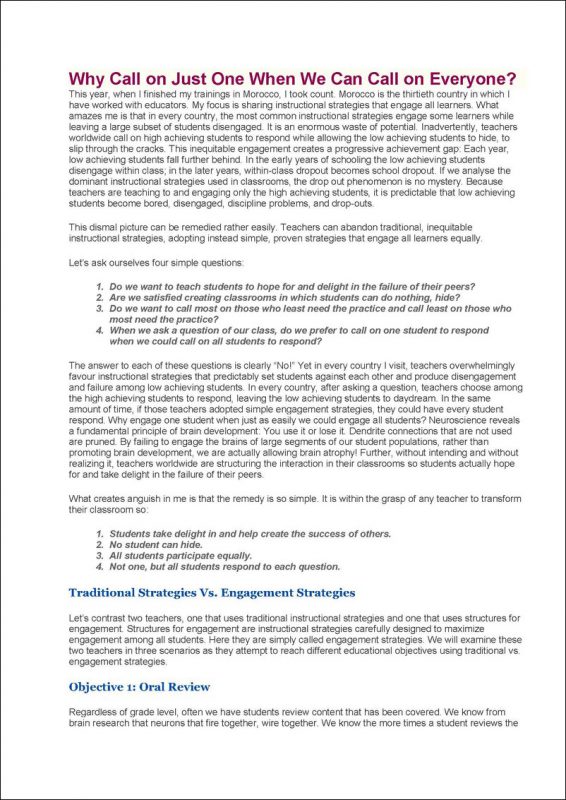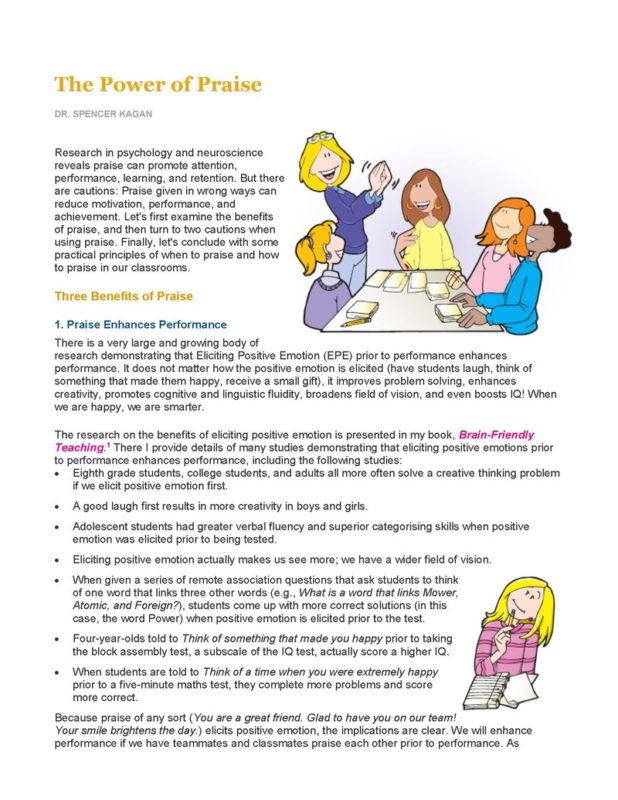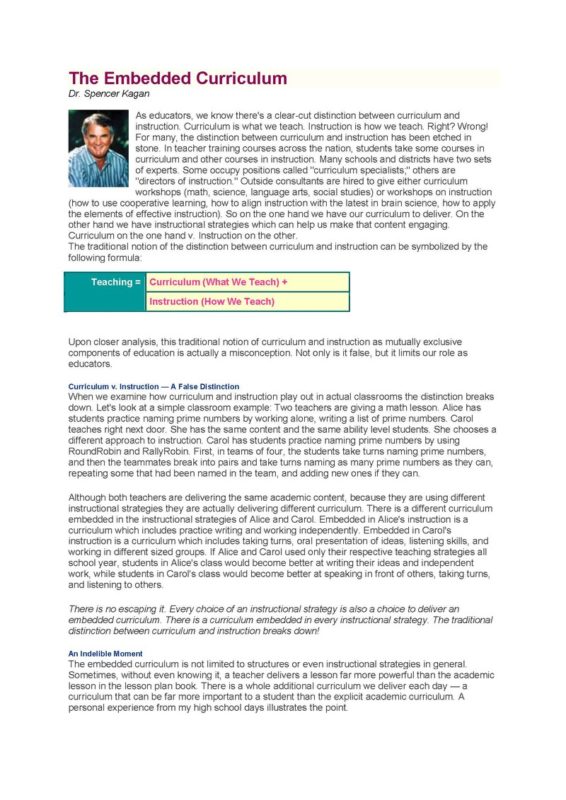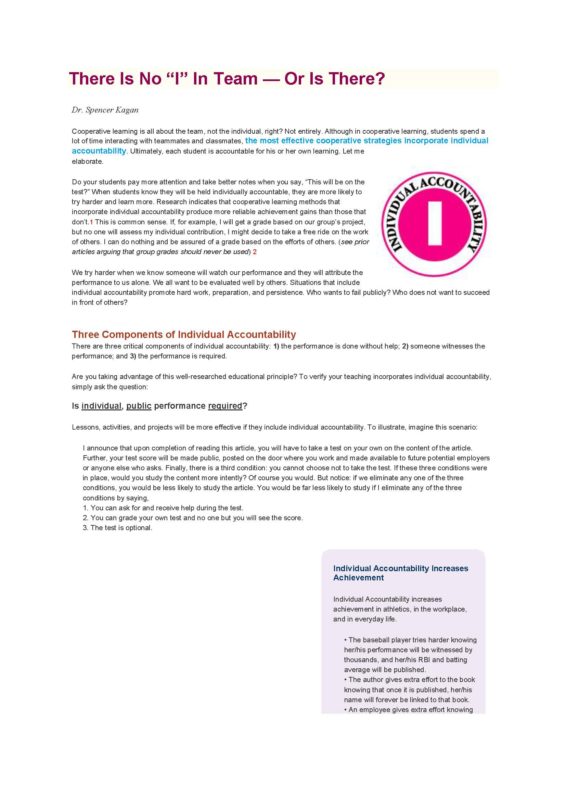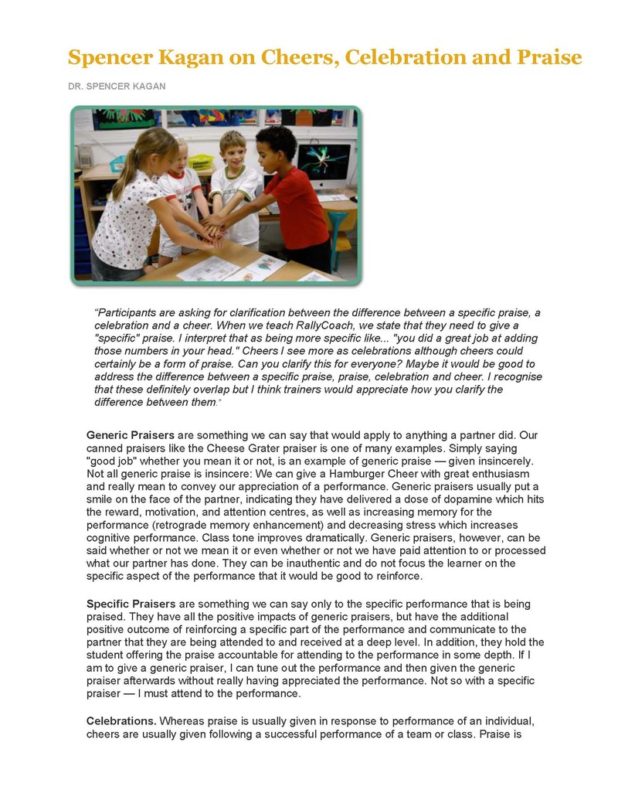Articles by Dr. Kagan
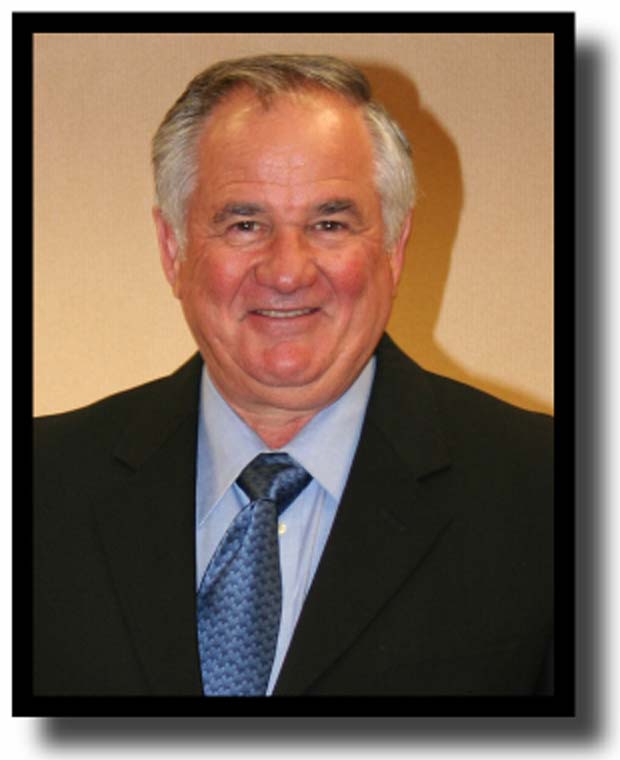
These are articles written by Kagan’s visionary leader. Articles feature Dr. Kagan’s invention, Kagan Structures.
Read Dr. Spencer Kagan’s provocative and insightful articles on Kagan Structures and how they have the power to transform education. You’ll also find Dr. Kagan’s thoughts on cooperative learning, multiple intelligences, the brain, character development, Win-Win Discipline and more.
Why do we advocate mixed teams rather than random teams or homogeneous teams? Here are 10 reasons why your base teams should reflect the diversity you have in your classroom.
Read ArticleThere is one thing that sets Kagan Publishing & Professional Development apart from all other educational publishing and professional development companies — Kagan Structures. Kagan Structures are at the heart of Kagan’s books and products. Spencer shares his personal account of the history of Kagan Structures, what’s coming up for Kagan in the near future, and his long-term vision.
Read ArticleWhy do some students persist in the face of setbacks and excel in school, while others give up easily, disengage and suffer academically? There are two theories that explain the difference between your high achievers and your at-risk students even more than does the difference in their intellectual abilities. The theories are Growth Mindset and Learned Helplessness. Growth Mindset and Learned Helplessness predict who will be resilient and who will give up.classroom. Understanding and applying these two theories allows us to foster growth mindset and to prevent learned helplessness.
Read ArticleDr. Kagan applies his successful, cooperative classroom approach to faculty meetings. Like classrooms, meetings that lack interaction, active participation by its members, a sense of belonging and control lead predictably to disengagement, frustration, and alienation. Dr. Kagan outlines a new, cooperative model for school meetings that empowers rather than alienates. The result is a shared vision and cooperative community of leaders and learners. Spencer introduces a new resource he and his associates created to help other leaders transform their meetings and their schools.
Read ArticleEducators face two challenges with academic achievement: 1) fostering academic excellence, and 2) creating equal opportunities for all students to succeed. Dr Kagan cites studies that show cooperative learning is a powerful approach to create excellence and equity.
Read ArticleDr. Spencer Kagan argues in this article that using group grades with cooperative learning is pointless. He argues that group grades are unfair, debase report cards, undermine motivation, communicate to students that their grade is a function of forces beyond their control, violate individual accountability, create resistance to cooperative learning, and are or should be illegal. A provocative article that explores nature of grading and our mission as educators.
Read ArticleDoes praise erode intrinsic motivation like rewards? Do we help or hurt our students with high-fives, pats on the back, and compliments? As you may have guessed from the title, Spencer lauds the positive effects of praise. Highlighting relevant research, Dr. Kagan provides insight to why praise helps students while rewards can hurt.
Read ArticleKagan Coaching is Kagan’s radically different approach to coaching teachers. Instead of observing a lesson, then providing feedback afterwards, Kagan provides coaching “in real time.” That is, the coach offers teaching suggestions and improvements whiles the teacher is teaching. Students get the benefit of doing the lesson right, but most importantly the teacher hears how his or her teaching could be improved, but witnesses first hand the dramatic difference that in-the-moment Kagan Coaching makes.
Read ArticleHow is the Kagan approach different from other approaches to teaching? To producing academic gains? To reaching the standards? To realizing the goals of cooperative learning, multiple intelligences, emotional intelligence, character development, and higher-level thinking? At the heart of Kagan workshops and publications are Kagan structures. Kagan structures convert principles into practice, producing positive outcomes for students, teachers, trainers, and schools.
Read ArticleTeachers using the Kagan Structures consistently report that their students are more engaged. This is no surprise. Kagan Structures are carefully designed to implement the four basic principles of cooperative learning: positive interdependence, individual accountability, equal participation, and simultaneous interaction (PIES). Each of these principles boosts engagement in different ways, ensuring, for example, participation from students who might otherwise hide and ensuring that at any one moment a greater number of students are actively engaged.
Read ArticleUse Kagan Structures to increase student engagement and language learning. Six favorite structures are presented for teaching English as a second language or for teaching any foreign language.
Read ArticleDr. Kagan provides a succinct answer to the question, “Why Kagan Structures?” Spencer cites the positive outcomes of using Kagan Structures, its strong research and theory base, and most importantly — the positive transformation that students and teachers experience by using Kagan Structures.
Read ArticleIn his research on brain-based learning, Dr. Kagan uncovered a wealth of studies on the powerful impact of using hand and body signals for teaching and learning. See how gesturing improves understanding and retention and learn ways you can incorporate Kinesthetic Symbols into your classroom to boost learning. Read ArticleOr click on the page to enlarge the image to preview the 1st page only.
Read ArticleIf we believe that students are different and learn in different ways, we have the power to reach more students by teaching in different ways. We open the doors to learning by matching our instruction to how students best learn. Here, the Kagans share the theory of Multiple Intelligences, the three MI Visions, and a few MI Structures to open the doors to learning.
Read ArticleChange can be great, but it can also be daunting. Change sometimes breeds fear. And that fear is oftentimes unfounded. Dr. Kagan responds to fears such as: “I fear students will get off task.” “I fear this is not appropriate for my students.” “I fear it’ll be too hard.” Whether you or someone you know is afraid to take the leap, we encourage you to read Dr. Kagan’s responses. Hopefully, this article will help tip the scales toward making the change—it’s worth it!
Read ArticleBloom’s Taxonomy is virtually synonymous with our thinking about and teaching of thinking skills. Although it has been a terrific advancement in our thinking and a practical tool for teachers, in three important ways Bloom’s Taxonomy does not align well with recent findings of brain science. Is it time for the educational community to rethink thinking?
Read ArticleDr. Spencer Kagan shares the Kagan structural approach to developing character. He argues that the need for character education is clear because the virtues we could once assume are eroding. He then identifies two approaches to developing character: the curriculum approach and the structural approach and highlights the advantages of the structural approach.
Read ArticleHow many students should there be on a cooperative learning team? Two? Three? Four? Five? Six or more? As the title suggests, Kagan advocates teams of four. Teams of four are magic. See why.
Read ArticleMark Twain said, “If teaching were the same as telling, we’d all be so smart we could hardly stand it.” Dr. Kagan shows how frequent processing converts telling into effective teaching.
Read ArticleAs the world turned around them, schools did not. At least they did not change in the most important way they needed to change – how teachers teach. We are now on the verge of an instructional revolution. In this article, Dr Spencer Kagan gives us a glimpse into the future of instruction.
Read ArticleStudents texting and goofing with their mobile phones in class is annoying. But the mobile phone is not the problem. The problem is the lack of highly-engaging teaching strategies. See how we can productively fulfill students’ need for social interaction.
Read ArticleFor several years, Kagan has been offering professional development on Win-Win Discipline. Win-Win Discipline was honoured by being selected as one of the pre-eminent programs and is featured in THE book on major educational discipline programs. Building Classroom Discipline. We continue to receive more and more requests for info about Win-Win Discipline. So here you go! Dr Spencer Kagan outlines Kagan’s discipline program and how it interfaces with Kagan’s other programs.
Read ArticleThis year, when I finished my trainings in Morocco, I took count. Morocco is the thirtieth country in which I have worked with educators. My focus is sharing instructional strategies that engage all learners. What amazes me is that in every country, the most common instructional strategies engage some learners while leaving a large subset of students disengaged. It is an enormous waste of potential. Inadvertently, teachers worldwide call on high achieving students to respond while allowing the low achieving students to hide, to slip through the cracks.
Read ArticleIn his research on brain science, Dr. Kagan discovered a vast array of studies touting the importance of praise. Praise enhances performance and memory. But watch out for the two praise pitfalls. Get expert advice on when to praise and how to praise in your classroom.
Read ArticleAs educators, we know there’s a clear-cut distinction between curriculum and instruction. Curriculum is what we teach. Instruction is how we teach. Right? Wrong! Hidden in our instruction is an embedded curriculum. And oftentimes the embedded curriculum is even more important than our explicit curriculum.
Read ArticleCooperative learning is all about the team, not the individual, right? Not entirely. Although in cooperative learning, students spend a lot of time interacting with teammates and classmates, the most effective cooperative strategies incorporate individual accountability. Ultimately, each student is accountable for his or her own learning. Let me elaborate.
Do your students pay more attention and take better notes when you say, “This will be on the test?” When students know they will be held individually accountable, they are more likely to try harder and learn more. Research indicates that cooperative learning methods that incorporate individual accountability produce more reliable achievement gains than those that don’t.1 This is common sense. If, for example, I will get a grade based on our group’s project, but no one will assess my individual contribution, I might decide to take a free ride on the work of others. I can do nothing and be assured of a grade based on the efforts of others.
Read ArticleCooperative learning is all about the team, not the individual, right? Not entirely. Although in cooperative learning, students spend a lot of time interacting with teammates and classmates, the most effective cooperative strategies incorporate individual accountability. Ultimately, each student is accountable for his or her own learning. Let me elaborate.
Do your students pay more attention and take better notes when you say, “This will be on the test?” When students know they will be held individually accountable, they are more likely to try harder and learn more. Research indicates that cooperative learning methods that incorporate individual accountability produce more reliable achievement gains than those that don’t.1 This is common sense. If, for example, I will get a grade based on our group’s project, but no one will assess my individual contribution, I might decide to take a free ride on the work of others. I can do nothing and be assured of a grade based on the efforts of others.
Read ArticleThe Kagan classroom is rich with cheers, celebrations, and praise. But what’s the difference? Dr. Kagan distinguishes between these ways to elicit positive emotions in the classroom and offers insights about timing
Read Article
